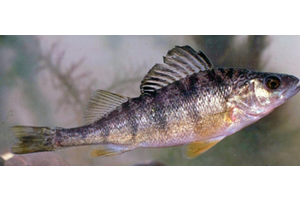Ultraviolet radiation can kill yellow perch eggs in shallow waters of lakes with low levels of dissolved organic carbon. Higher concentrations of dissolved organic carbon, which largely comes from the decomposition of plants, may reduce this damage by limiting the penetration of ultraviolet radiation.
Photo Credit: Geoffrey A. Hammerson
Perca flavescens
Common Name: yellow perch
Animal Guild: Fish
Class > Order > Family: Teleostei > Perciformes > Percidae
What does the species look like?
Yellow perch have a fairly deep and compressed body and two dorsal fins. Their tail fin is moderately forked. They are green on the upper side, yellow on their sides, and have six to nine green-brown saddles or bars on their sides. They have a black blotch at the rear of their first dorsal fin. Their paired fins are yellow to red. Their large mouth extends back to the middle of their eye. They can reach a total length of around 15.8 inches (40 cm).
Eggs: They lay eggs in pleated or folded, gelatinous strands up to several feet long.
Where is the species found?
States & Provinces
AB, AL, AZ, BC, CA, CO, CT, DC, DE, FL, GA, IA, ID, IL, IN, KS, KY, MA, MB, MD, ME, MI, MN, MO, MS, MT, NB, NC, ND, NE, NH, NJ, NM, NS, NT, NV, NY, OH, OK, ON, OR, PA, QC, RI, SC, SD, SK, TX, UT, VA, VT, WA, WI, WV, WY
Distribution
This species is native throughout much of northern North America east of the Rockies in Atlantic, Arctic, the Great Lakes, and Mississippi River basins; from Nova Scotia and Quebec west to Great Slave Lake, Northwest Territories, and south to Ohio, Illinois, and Nebraska; and south in Atlantic drainages to Santee River, South Carolina. It has been introduced in most western states and elsewhere.
General Phenology and Life History
In late winter or spring, yellow perch spawn in quiet water with submerged beds of aquatic plants or brush, sand, gravel, or rubble. Sometimes they migrate into streams to spawn. They lay eggs at depths of up to 13 feet (4 meters). Eggs hatch about 10 to 20 days after they are laid.
Which phenophases should I observe?
Do you see/hear...?
Activity
Adults in freshwater More...
For abundance, enter the number of individual animals observed in this phenophase.
Adults feeding For abundance, enter the number of individual animals observed in this phenophase.
Development
Dead or dying adults For abundance, enter the number of individual animals observed in this phenophase.
Method
Individuals on a hook For abundance, enter the number of individual animals observed in this phenophase.
Individuals in a net For abundance, enter the number of individual animals observed in this phenophase.
What do these phenophases look like?
There is currently no photoguide available for this species. If you'd like help us create one, use the guidance document and species template provided here . Then send it via email to education@usanpn.org when it is complete.
